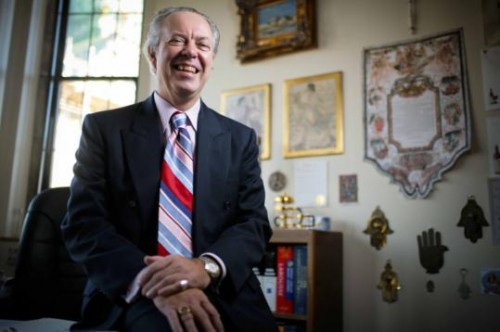What Is Exaggerated Modern?
UPDATE: In our carelessness we omitted citation for the image of “Donald’s Serva-teria. We got it here, and apologize for the oversight.
– Joe Sipowicz
In our previous post here we identified the buildings at the Hope University campus as “Exaggerated Modern.” Being unusually perspicacious, we have anticipated that some of our Friends will want an explanation of what this architectural term means, and that some even may suspect that we just make this stuff up for fun.
And so we have called upon the good offices of Dr. Ralph E. Haldemann, Art History Professor (Emeritus) at Otterbein College, Ohio – our adjunct Arts and Architecture editor – to expound upon the term he so helpfully provided for our prior post. We reproduce his scholarly explanation below:

The term “exaggerated modern” simply means a style that uses the materials and structural emphasis of Modern architecture, with exaggerated features: soaring, cantilevered roofs, expansive and often canted storefronts, and the deployment of exposed structural elements like precast concrete, steel trusses, etc., to emphasize engineering virtuosity. The style is resolutely exuberant, commercial, and auto-oriented. The style dominated American roadside architecture between 1955 and 1965, and even made inroads into high-style architectural efforts such as the buildings at Hope U.

Exaggerated Modern ought not to be confused with the term “googie” – an applique design phenomenon that in some ways parallels Exaggerated Modern. Googie themes tend to be kitschy renditions of popular 1950s scientific imagery – atomic, astronomic, and zoological (amoeboid shapes); or fun arrangements of geometric shapes, patterns, and colors, etc. These energetic and playful themes will very likely be housed in structures exhibiting Exaggerated Modern attributes, or on attached or adjacent signage; but the two notions should not be conflated.

Professor Chester H. Liebs has aptly described the outlines and history of Exaggerated Modern in his magisterial book From Main Street to Miracle Mile, Little Brown & Co., Boston, 1985. cf. pages 59-64. click here to see
Thanks, Dr. Haldemann. The check is in the mail!
I gotta say, from that angle the roof of the auditorium reminds me Sally Field in The Flying Nun.
Yes, that was the inspiration. Elevated Catholic.
This is an absolute rocking post.
Glad you like it k. We try to be informative and incisive. too.
Googie and Exaggerated Modern ARE the same thing. Look at the works of Googie’s key architects (e.g. Armet & Davis) and tell me Googie ISN’T an exaggerated form of Modern architecture.
Haldemann (from that hotbed of Googie,… OHIO,) is still clinging to the old saw that Googie is junk and therefore any well-designed building in that style must be reclassified as something else,… like Exaggerated Modern.
Or perhaps, like some other academics, he’s just uncomfortable with the admittedly silly-sounding word “Googie.”
To that I say, “Googie, Googie, Googie!!!”
Chris, where did you get the idea that Dr. Haldemann thought that Googie “is junk”?
After assigning most of Googie’s best traits to “Exaggerated Modern”, he goes on to define Googie not even as true architecture but as “an applique design phenomenon,” and goes on to call it kitschy. Sort of writing it off, no?
It sounds more like he’s describing dingbats, or only the weakest examples of Googie.
This certainly isn’t a big deal, but it’s a bit frustrating because it hearkens back to the bad old days when MANY people wrote Googie off as a kitchy applique design phenomenon.
Chris, thanks for your comment.
What are googies’ “best traits” – from an architectural standpoint? Wavy amoebas on the wall and models of electrons zipping around an atomic nucleus atop a pole sign are not architecture. Please note that the buildings at Hope U are clearly distinguishable from a 50’s coffee shop.
How do “dingbats” figure into this? Please elucidate.
Chris, after reading this post I checked out Liebs book on roadside architecture. He makes a clear case – well documented – for a vernacular commercial architectural style that he calls “Exaggerated Modern.” Liebs is not some snotty ivory tower intellectual who disparages your precious “googie.” He just puts it in its proper perspective – as somebody who has obviously logged untold hours on the road.
Professor Haldeman (rightly it seems to me) suggests that Exaggerated Modern, in some instances has been deployed (by architects) as an effort to make serious architecture.
And absolutely nobody (here, anyway) has argued that “googie” is a part of the built environment not worth preserving for its own sake.
Hey, that’s my copyrighted photo of Donald’s Servateria from this post: http://thelope.com/2005/10/googie-treasure-in-pratt-ks.html
Please add a clickable photo credit. Thanks.
Greg, the images were added to the text by our old blogger The Fullerton Harpoon who alas, has shuffled of this mortal coil.
However I’ll be happy to add the link. Sorry for the oversight.
Thank you.